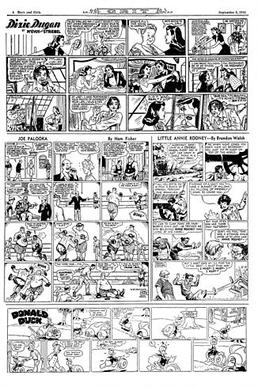History
Virgil McNitt (1881–1964) first tried his hand at publishing a magazine, the McNaught Magazine, which failed. [1] He then, in 1910, started the Central Press Association syndication service, with offices in Cleveland, Ohio. [2] In 1920, McNitt founded the Central Press Association of New York City. (Although both services had the same name, they were separate operations.) [3]
In 1922, McNitt and Charles V. McAdam (1892–1985) absorbed the operations of the New York City Central Press Association [3] and co-founded the McNaught Syndicate, with headquarters in The New York Times building. [4] [5] Will Rogers' weekly column started in 1922 in 25 newspapers. By 1926, his daily column ran in 92 newspapers, and it reached 400 papers three years later, making him one of the best paid and most read columnists of the United States at the time. [6]
From 1925 until 1951, Charles Benedict Driscoll was one of the editors and contributors for the syndicate. [7]
Writers syndicated by McNaught in those first years included Paul Gallico, Dale Carnegie, Walter Winchell and Irvin S. Cobb. [8] By the early 1930s, the McNaught Syndicate had a stable which included columnists O. O. McIntyre and Al Smith and at one time even syndicated a letter by Albert Einstein. [9]
Other successes included columns by Dale Carnegie and Dear Abby by Abigail Van Buren. At the time of McNitt's death in 1964, the syndicate was still led by McAdam, providing contents to 1,000 newspapers. [4]
By 1987, McNaught had only 24 features left, making it the tenth largest comic strip syndicate in the United States at that time. [10] The syndicate eventually folded in September 1989. [11]
Comic strips
One of the first syndicated artists was Rube Goldberg. McNaught's line-up of comic strips included Mickey Finn and Dixie Dugan . Ham Fisher's Joe Palooka was at first rejected by McNitt, but Fisher was hired as a salesman for the syndicate, offering McNaught's features to newspapers. After having sold his comic to 20 newspapers, McNitt had to change his opinion and added Joe Palooka to the syndicate, becoming one of the big successes for it. [12]
By the mid-1930s, McNaught's stable of cartoonists included Fisher, John H. Striebel, and Gus Mager. [3]
In 1933, just as the concept of "comic books" was getting off the ground, Eastern Color Printing published Funnies on Parade , which reprinted in color several comic strips licensed from the McNaught Syndicate, the Ledger Syndicate, Associated Newspapers, and the Bell Syndicate, [13] including Ham Fisher's Joe Palooka . Eastern Color neither sold this periodical nor made it available on newsstands, but rather sent it out free as a promotional item to consumers who mailed in coupons clipped from Procter & Gamble soap and toiletries products. The company printed 10,000 copies, and it was a great success. [14] [15]
In 1937, the McNaught Syndicate partnered with Frank J. Markey (formerly a McNaught executive) [16] and the Register and Tribune Syndicate, as well as with entrepreneur Everett M. "Busy" Arnold, to provide material to the burgeoning comic book industry. [17] For this reason, from 1937 until 1939, many of the syndicate's comic strips were reprinted in the comic book anthology Feature Funnies (published by Arnold). In 1939, Cowles Media Company (the Register and Tribune Syndicate's corporate owner) and Arnold bought out the McNaught and Markey interests. [18]
In 1939, the syndicate hired Vin Sullivan, then editor of Action Comics , to start a new comics publishing company, Columbia Comics, which would carry both new comics and reprints of McNaught syndicated comics like Joe Palooka. The company existed until 1949 and is best remembered for their publication Big Shot Comics . [19]
The syndicate continued columns and strips which were already successful when acquired, but it also was active in creating and suggesting new content, from the Will Rogers columns to comic strips like Don Dean's Cranberry Boggs. [20] In one case, McNitt supported a crossover between the comic strips Joe Palooka and Dixie Dugan, a feat which was commented upon by Editor & Publisher . [21]
Their last success came with the comic strip Heathcliff , which they syndicated from the start in 1973 until the late 1980s. Heathcliff appeared in some 1,000 newspapers, and the McNaught Syndicate became the production company for a few Heathcliff movies, including Heathcliff: The Movie from 1986. [22]
This page is based on this
Wikipedia article Text is available under the
CC BY-SA 4.0 license; additional terms may apply.
Images, videos and audio are available under their respective licenses.

